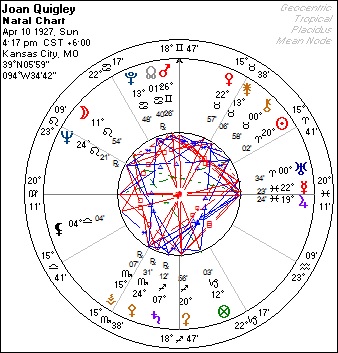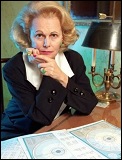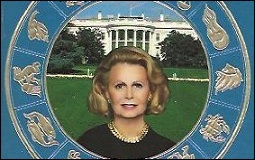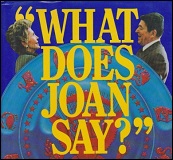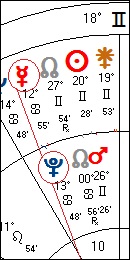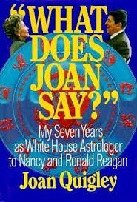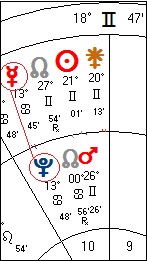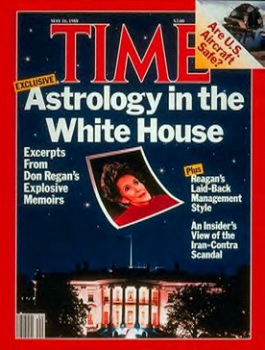Astrology
in the White House
Joan Quigley
and the
Part of Fortune
NeptuneCafe presents....
If you look through the work of Noel Tyl, Liz Greene, Stephen Forrest, or any number of respected modern astrologers, you won’t find anything about the Part of Fortune. Books written specifically about predictive astrology talk about outer planet transits, progressions and solar returns, but none (zero, nada, zilch) discuss the Part of Fortune. To find out about the Part of Fortune, which is also called Fortuna or the Part of Joy, one must turn to the classic texts. In the modern astrology library, the best sources for information on Fortuna are the horary astrology texts.
Martin Schulman has the most comprehensive take in his 1978 book, Joy and the Part of Fortune, where he delineates natal Fortuna by sign and house. Also, Judith Hill has published a useful pamphlet on the subject: The Part of Fortune in Astrology. As for making predictions, I found Ivy Goldstein-Jacobson’s Simplified Horary Astrology to be unsurpassed.
Here are a few snippets about how these authors use the Part of Fortune. Schulman writes, "The Part of Fortune symbolizes that place in the horoscope through which the Sun, Moon, and Ascendant are in best harmonic relationship to each other and are easily expressed to the greatest advantage for the individual.”
Hill describes the Part of Fortune as surviving from ancient times, unlike the other main Arabic Parts. “It was called the ‘place of happiness’ by astrologers of a generation previous to ours, and indeed, will function as such. Oddly, this meaning seems lost among today’s astrologers. We tend to value highly that which brings us happiness.”
Horary astrologers distinguish between a well-aspected Part of Fortune and an “afflicted” Part of Fortune, which is re-named the “Part of Misfortune”. Goldstein-Jacobson writes, “The Part of Fortune is a point representing the person’s substance to some extent, and (if well aspected) the person will possess a ‘fortune’ according to his sense of values.” She further describes how the Part of Fortune becomes the Part of Misfortune when “badly aspected” by Mars, Neptune, or conjunct an “evil fixed star”. Also, this Part becomes misfortunate when located in the 8th or 12th house.
In practice, the Part of Fortune is an indicator for where the individual may find happiness or financial gain. If Fortuna has challenging aspects to it, a sense of chronic unhappiness or lack of financial security may result. These psychological states of well-being heighten (or worsen) when major transits and/or progressions activate the Part of Fortune. Also, one may use the progressed Part of Fortune to make forecasts or predictions. In the case of political elections, the conditions of a candidate’s progressed Part of Fortune may indicate victory or defeat.
To make use of the Part of Fortune, one will need an astrology calculation program. The free online charts available at various websites (such as alabe.com or astro.com) don’t display the Part of Fortune. And in order to make predictions or forecasts, astrology calculation software is essential. Getting an accurate picture about what’s happening to an individual now and in the future depends not only on being able to use outer planet transits, but also progressions.
In my opinion, intermediate and professional astrologers make a huge mistake when they rely solely on transits to make forecasts. Progressing the chart shows the internal development which then manifests as external events. The formula for progressions is an esoteric projection, which I liken to the fractal nature of our collective reality. One day after birth is symbolically equivalent to one year after birth. For more about the value and use of progressions, please visit my webpage on the subject: neptunecafe.com/progressions
The progressed Part of Fortune is calculated by adding the progressed Moon to the progressed Ascendant, and then subtracting the progressed Sun. It moves at the same rate as the progressed Moon, which is to say, about one degree per month. Again, the math is instantly calculated with a decent astrology program. It’s only one of many indicators that might be used in judging the outcome at any one point in the future, such as elections.
The Part of Fortune
Reagan’s Astrologer
Joan Quigley
The Part of Fortune (PF) can key us in on important natal configurations that may otherwise seem ordinary or even inconsequential.
Consider astrologer Joan Quigley’s chart as an example. Her PF at 12º Capricorn is located in the 4th house of home and family. Quigley lived in a classically furnished, luxurious Nob Hill residence where she conducted her business with the Reagan White House over the phone.
Often referred to as a “San Francisco socialite”, Quigley steered Reagan away from his notion that Russia was an “evil empire,” and toward the historic nuclear disarmament treaty with the Soviet premier, Mikhail Gorbachev. Columnist Molly Ivins commented after Quigley died in 2014, “There the poor woman was, sitting in San Francisco with full accountability for world peace, and none of us even knew her name.”
Quigley’s PF forms a close trine to Juno at 13º Taurus. Juno is sometimes known as “the Queen of the Goddesses”, which enhances her status as a Nob Hill socialite. And in earthy Taurus, it increases the potential financial rewards attached to her PF. Note that Juno squares the Leo Moon, which tends to give her a royal attitude about her self-worth.
In her book, What Does Joan say?, Quigley discusses what Nancy Reagan paid her: “The Reagans did not have vast wealth. Nancy offered to pay me, yes. But … she could not afford to pay me even a fraction of what I was worth. I could not have done this for the Reagans had I not other sources of income.” In fact, Nancy Reagan paid her $3,000 a month for her advice over the seven years she secretly served the White House.
Most importantly, Quigley’s PF opposes Pluto at 13º Cancer. Pluto here is exactly conjunct the U.S. Sun and, located in the 10th house of public leadership, is naturally associated with American presidents. And her Moon at 11º Leo is located in the 11th house of friends. Through her friendship with Nancy Reagan, Quigley gained unparalleled influence over the nation’s primary concerns. As she stated in her book, “Not since the days of the Roman emperors — and never in the history of the United States Presidency — has an astrologer played such a significant role in the nation's affairs of State."
To sum up, her PF is one of a family of placements. It connects to her social network (Moon in 11th), her influence over the nation (Pluto in 10th), and to the publishing world (Juno sits on the 9th house cusp). The whole business was all conducted from her home (Fortuna in 4th). Juno is particularly interesting when we look at how her astrology service was eventually revealed to the public through a series of three memoirs, each peeling off another layer of her enigmatic role.
It began on May 3, 1988 when Reagan’s former aide, Donald Regan, published his insider’s look at the Reagan White House, For the Record. For the first time, the public became aware that an astrologer was guiding the president. In his book, he wrote, “Virtually every major move and decision the Reagans made during my time as White House Chief of Staff was cleared in advance with a woman in San Francisco who drew up horoscopes to make certain that the planets were in a favorable alignment for the enterprise.”
the story continues below....
The material on this page was written and designed by Michael O'Reilly. It's an excerpt from the full length article published in the February 2016 issue of Dell Horoscope.
Reporters quickly tracked down the name of the astrologer, and Joan Quigley became an over-night sensation. We can get a picture of what was happening just by looking at the progressions. First, recall that Juno’s symbolism is associated with the wife, and in this case, with publishing (by
being located on the 9th house cusp), as well as her role as a socialite.
By secondary progression Juno had reached her Midheaven and was exactly conjunct her progressed Sun (orb: 0º02’). She was identified (the Sun) as the First Lady’s friend and adviser (Juno), and made
famous (Midheaven). The progressed PF had just entered the 7th house of “others”. She was outed by Donald Regan. The progressed PF was squaring her progressed Sun-Juno conjunction and Midheaven. The square indicates the challenging turn of events, which manifested through Nancy Reagan’s rival, Donald Regan.
Another member of Quigley’s natal Fortuna aspects is Pluto, but since it hardly moves by secondary progression, we can consider Pluto’s transits. When Regan’s stunning memoir was published, transiting Pluto was at 11º Scorpio, setting off the entire network of planets connected to Quigley’s PF. At the time, Pluto was most closely aspecting the Leo Moon by a challenging square, creating an emotionally intense environment. Over the ensuing months, Pluto would hit every placement in Fortuna’s aspect network, leading to further revelations and memoirs.
On October 18, 1989, Nancy Reagan published her perspective of events in the bestseller, My Turn: The Memoirs of Nancy Reagan. She described Quigley as being warm and compassionate, but downplayed her role as an influential astrologer. She does admit that she consulted Quigley as an
astrologer, beginning after the president was shot by John Hinckley in 1981. She writes, “I'm a worrier, and now I really had something to worry about: that it might happen again, and that this time, I would lose him forever. Astrology was simply one of the ways I coped with the fear I felt after my husband almost died."
The progressions and transiting Pluto once again highlight Quigley’s PF. At the time, transiting Pluto was trine natal Pluto and sextile natal Fortuna. Progressed Mercury at 12º Cancer was now perfectly opposite her natal PF and heading into the conjunction with her 10th house Pluto. Quigley received another wave of public attention, including from a wide range of harsh, superstitious
critics. For example, famed astronomer Carl Sagan wrote, “Some portion of the decision-making that influences the future of our civilization is plainly in the hands of charlatans.” Others weren’t as kind.
Joan Quigley was disappointed that her friend Nancy wasn’t more forthcoming about her role, so she published her own version of events in May 1990. At the time, her progressed Mercury was now exactly conjunct natal Pluto (orb: 0º06’). The title, “What Does Joan Say?”, comes from President
Reagan’s question to his wife when he was weighing his various options.
Vocal Mercury was telling the U.S. president how to reconcile with the Soviets, and days to stay indoors in order to avoid another assassination attempt.
During the unfoldment of these three historic memoirs, Quigley’s progressed PF was making its way through her 7th house, as each participant had their say. Donald Regan kicked it off when progressed Fortuna entered the 7th house. Nancy Reagan followed when the progressed PF was at 7º Aries, where it formed a harmonious trine into Quigley’s 3rd house Saturn. This aspect denotes how the First Lady and Quigley communicated, which was two or three times a day via Nancy’s private telephone line in the White House.
When Quigley published her memoir, progressed Fortuna was at 14º Aries, squaring her natal PF and its network of aspects. Also, by this time transiting Neptune in Capricorn was conjunct her 4th house PF, squaring her progressed PF, and opposing her 10th house Pluto. Her book laid out her daily duties as an astrologer to the president, and got back at the Reagans for denying her influential, historic role. Part of Fortune opposite Pluto has its vengeful side, and for Quigley, this was her moment of happiness.
The Part of Fortune Defined
The Part of Fortune is a projection of the Sun-Moon phase from the Ascendant degree. Expressed mathematically, it’s the Ascendant plus the Moon minus the Sun. Astrology programs routinely calculate the Part of Fortune for any horoscope. (The author uses the daytime formula and not the day/night time formula advocated by some. If you're using SolarFire to calculate your Part of Fortune, the default setting is the misguided day/night time formula. Here's how to fix that: go to the toolbar and click on Preferences. Under "Calculations" click on "Fixed Formula". Then click "OK".)
With Virgo Rising, Mercury is Quigley’s ruling planet. It’s location in the 7th house of others and conjunct Jupiter denotes her role as a wise adviser. Now that Mercury had progressed to her 10th house Pluto (symbolizing her client, the president), the title of her book perfectly synchronizes with the astrological symbolism.

